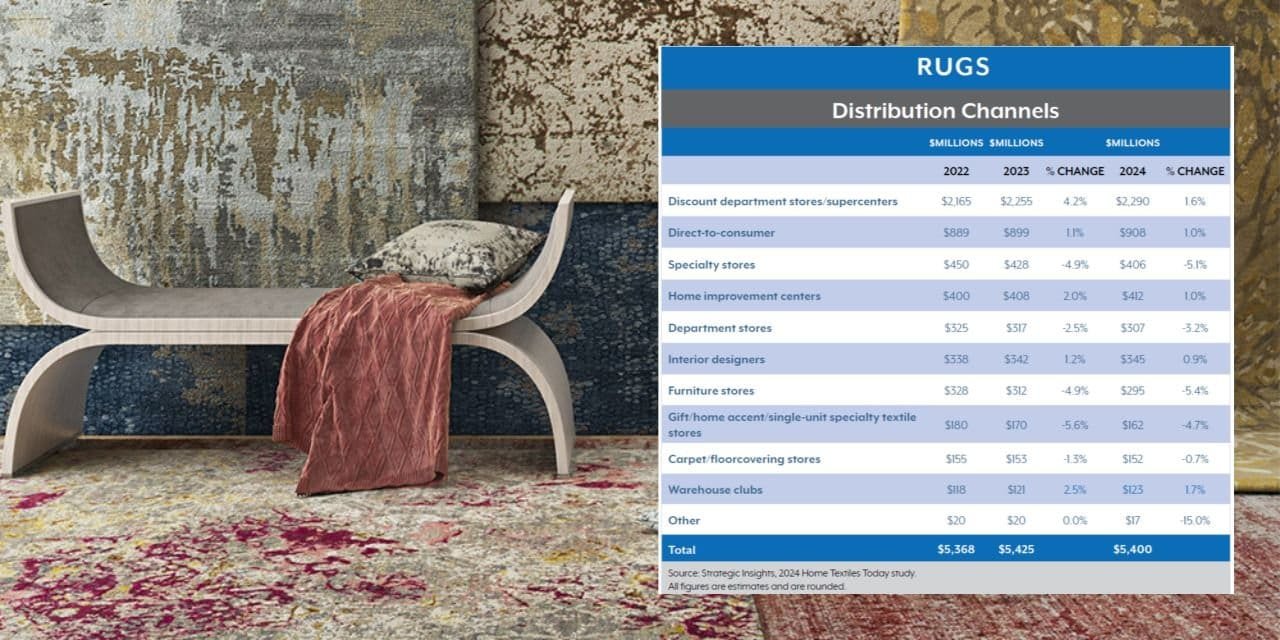New York— Once supported by the boom in home décor during the COVID-19 pandemic, the area rug market is now confronting significant obstacles in practically every aspect of its operations.
As a result of ongoing inflation, political unpredictability, and rising prices for products and services, sales began to decline sharply in the spring of 2024, affecting both consumers and companies. The future for the business is still complicated as it moves into 2025, but there is cautious but noticeable hope for a comeback.
As customers made investments in home renovations during the pandemic, the area rug category experienced a notable uptick in sales, similar to most other home goods categories. Into 2023, this tendency barely persisted. Although they were considerably below the epidemic high, retailers saw flat to modest rises in business levels. As the year went on, consumers’ preferences and spending habits started to change, with reluctance among buyers being exacerbated by high inflation and economic uncertainty.
“We had a stable year in 2023, but the pandemic’s excitement has subsided,” Capel Rugs’ president of sales, marketing, and imports, Cameron Capel, told HTT. The rug category struck the wall by 2024’s first quarter. Spending fell as a result of the tighter economy, and many stores saw their rug sales come to a sudden halt.
“It has been a general decline,” Capel went on. “Our high-end products have been an exception, as they are less impacted by changes in the economy.”
Moving upmarket to drive sales
High-end goods are turning out to be a lifesaver for certain businesses as consumer spending is still influenced by economic factors. For instance, Capel Rugs is concentrating on more affluent clients who are steadfast in the face of economic instability. High-end, handcrafted rugs from the brand, like hand-knotted and tufted wool types, have held up well because these customers are less impacted by inflation. Large rug sizes have been discreetly lowered by the manufacturer to reduce shipping costs and steer clear of hefty freight carrier surcharges.
Capel clarified, “We’ve changed the sizes to hit just under eight feet whenever and wherever possible.” “It has helped to minimize those fees for the end consumer who is stuck with that additional expense, as a rug that once shipped for $50 might now cost $250 extra to get out the door.”
In a similar vein, Kaleen has taken action to prevent excessive transportation expenses while increasing the appeal of its products to luxury markets. Kaleen’s chief operating officer, Monty Rathi, stated, “Our Luxe Collection is designed with foldability in mind, making it efficient for shipping without incurring surcharges.”
It is anticipated that this trend toward more upscale goods would continue until early 2025, with some businesses counting on a rebound in consumer confidence under the incoming presidential administration. However, customers on a tight budget are still reluctant to make luxuries, especially when it comes to home décor.
Challenges mount for machine-made constructions
Despite the difficult climate, Maples Rugs has a number of advantages over its rivals thanks to its vertically integrated business model that is based entirely on domestic manufacture.
According to Wade Maples, proprietor of Maples Rugs, the “one true domestic producer of rugs left in the U.S.,” “the business for machine-made rugs has not been strong, that’s true, but we are hopeful it will soon start to improve.” The family-run business creates printed area and accent rugs as well as tufted carpets using yarn that has already been colored.
He went on to say, “We manufacture all of our product, store it, and ship it.” “Because we ship directly, the retailers pay the freight instead of the customers, allowing us to ship faster and more consistently than our competitors.”
The machine-made rug industry faces a distinct set of difficulties, whereas luxury goods are showing some resiliency. Due to intense competition and a flood of cheaper imports, especially from Turkey, the market is congested and prices are falling.
Once seen to be affordable solutions with diversity and adaptability, machine-made rugs are now more often considered as commodity goods with little distinction, particularly in online marketplaces. Bart Hill, senior vice president of Mohawk Industries, told HTT, “It’s turned into a pure pricing war.” “E-commerce has made it hard for suppliers to stand out, turning the category into a race to the bottom.”
Because of this, some businesses are reevaluating their investments in machine-made rugs in favor of more expensive specialty items that work better in physical stores where customers can see them for themselves. Independent department stores and home décor stores are finding it difficult to compete with warehouse clubs and mass market retailers, which have become important outlets for these volume-driven products.
Looking for an upswing in the demand cycle
Manufacturers are optimistic that 2025 may see a recovery in demand despite these obstacles. Companies predict that if economic conditions normalize, there may be pent-up demand for house upgrades, as many consumers haven’t upgraded their home decor since the early epidemic years.
According to Larry Mahurter, senior vice president of marketing at Couristan, there has been an increase in demand for upscale and personalized area rugs. The demand for personalized rug patterns has been high, and Couristan, which recently launched a comprehensive line of hand-loomed carpets, is actively growing this market. “Customers who haven’t updated their home décor in years have unrealized potential,” he stated. “We expect a rebound in demand as stability begins to return.”
Competition from other industries is another element influencing consumer spending in the rug market. Giovanni Marra, vice president of marketing and creative at Nourison, claims that shifting customer preferences following the epidemic have also contributed.
According to him, “some consumers are spending their disposable income on experiences, like travel and events, rather than home decor,” and the furniture and décor industries as a whole have been impacted by this change.
Some businesses are adopting diversification as a strategy to navigate a challenging market in the midst of the industry’s difficulties. By purchasing Foss Flooring in 2022, for example, Mohawk Home expanded its product line beyond beautiful rugs to include useful items like utility flooring in addition to doormats and rug pads. By diversifying, Mohawk has been able to better withstand changes in the market for area rugs with a fashion focus and penetrate new retail channels.
“At the moment, the rug industry is overstocked and overcapable,” Hill continued. “We’ve adjusted by introducing value-driven items and branching out into non-traditional segments. We think that in order to survive in this harsh environment, diversification is crucial.
The area rug sector is at a turning point, much like the whole economy. Consumer confidence is waning, inflation is still a factor, and retailers and manufacturers are being forced to make tough decisions. This year has been one of adaptation and resilience due to rising transportation costs, pressure from competitive pricing, and changing customer priorities.
Many businesses are currently implementing strategic changes, such as cutting sizes to avoid surcharges or concentrating on luxury markets that are less impacted by changes in the economy.
Manufacturers, distributors, and retailers are relying on these adjustments to help them weather the storm and get ready for the recovery they anticipate in 2025 as they adapt to this “new normal.”
Hill asserted that there is hope for the future. When the economy stabilizes, we expect a more stable atmosphere and think that consumers will resume buying home décor. And the sooner rather than the later, the better.

